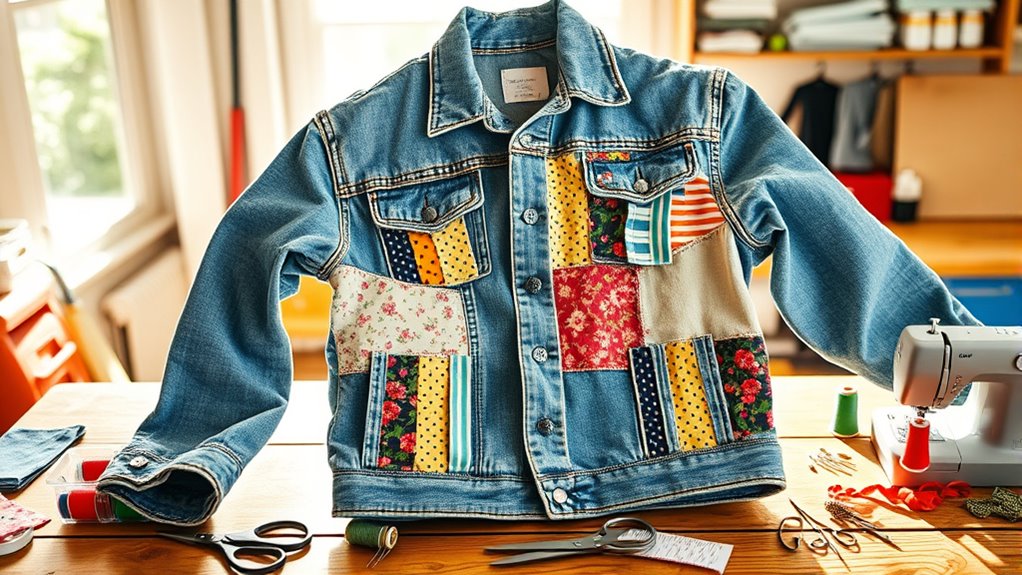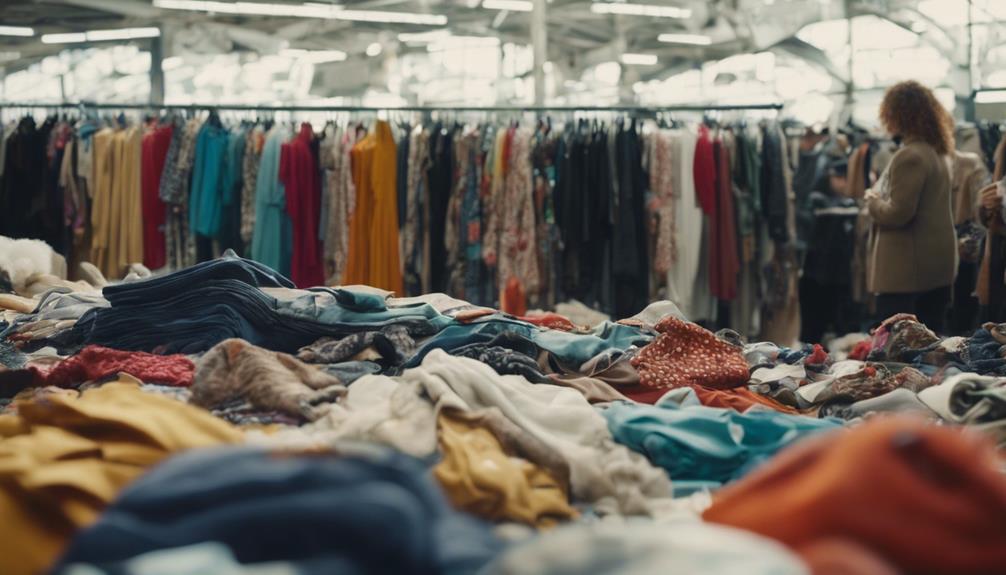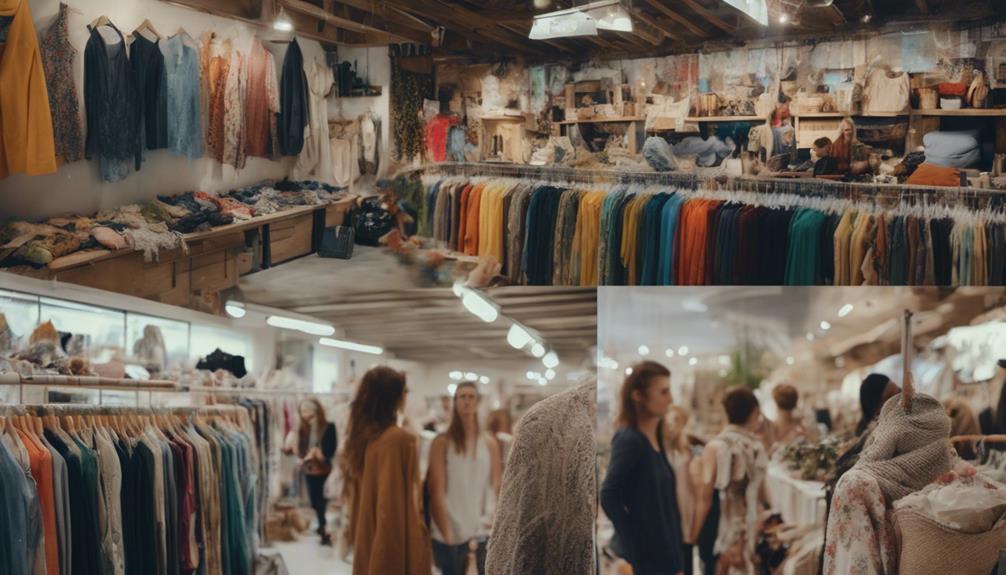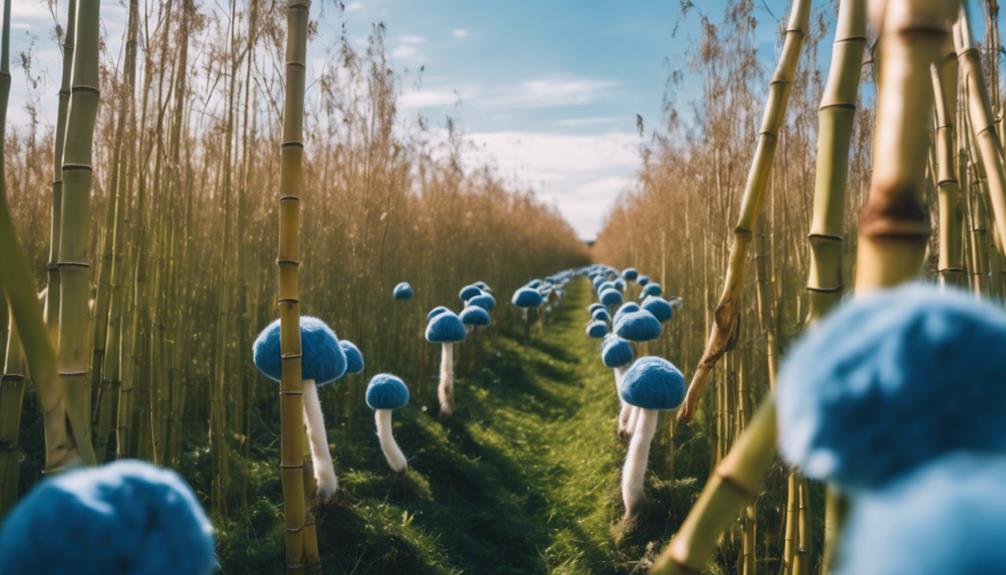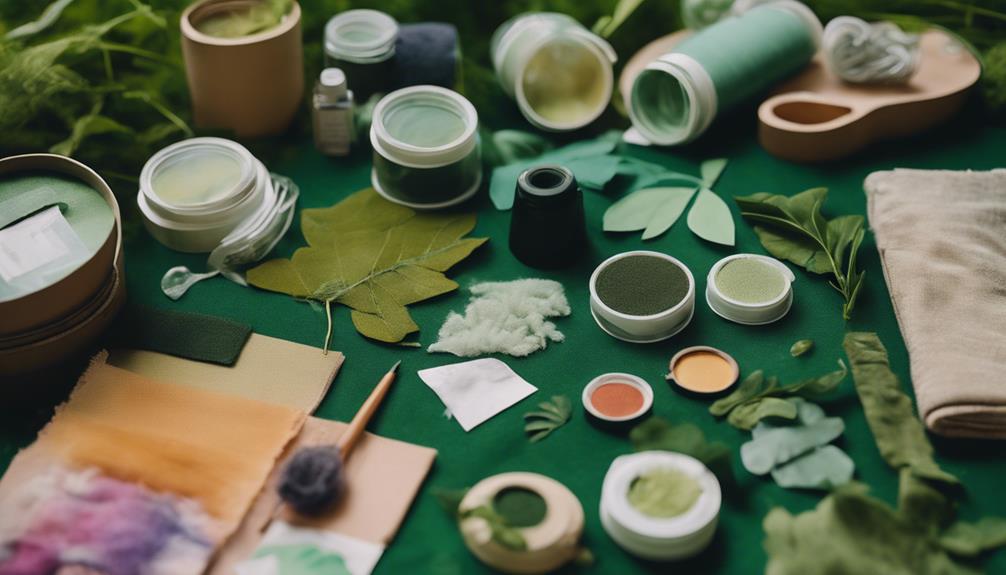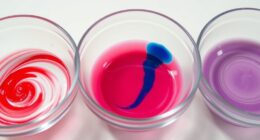Upcycling and repurposing old clothes let you turn waste into creative, sustainable treasures. You can transform T-shirts into trendy tote bags, old jeans into stylish shorts or skirts, or fabrics into cozy patchwork quilts. Adding embellishments or converting shirts into pillow covers gives your items a fresh look. These projects help reduce landfill waste and support eco-friendly living. Keep exploring to discover more inspiring ideas that give your clothes a new, fashionable life.
Key Takeaways
- Upcycling transforms old clothes into new, stylish items like tote bags, shorts, or quilts, reducing textile waste and promoting sustainability.
- Repurposing techniques include cutting, sewing, and embellishing to create personalized accessories and home decor from existing garments.
- Proper organization and precise sewing methods ensure durable, polished results in upcycled clothing projects.
- Adding patches, fabric paint, and embellishments customizes old clothes, giving them a fresh, unique appearance.
- Upcycling supports eco-conscious living by extending the lifecycle of textiles, minimizing landfill waste, and conserving resources.
Transforming T-Shirts Into Trendy Tote Bags
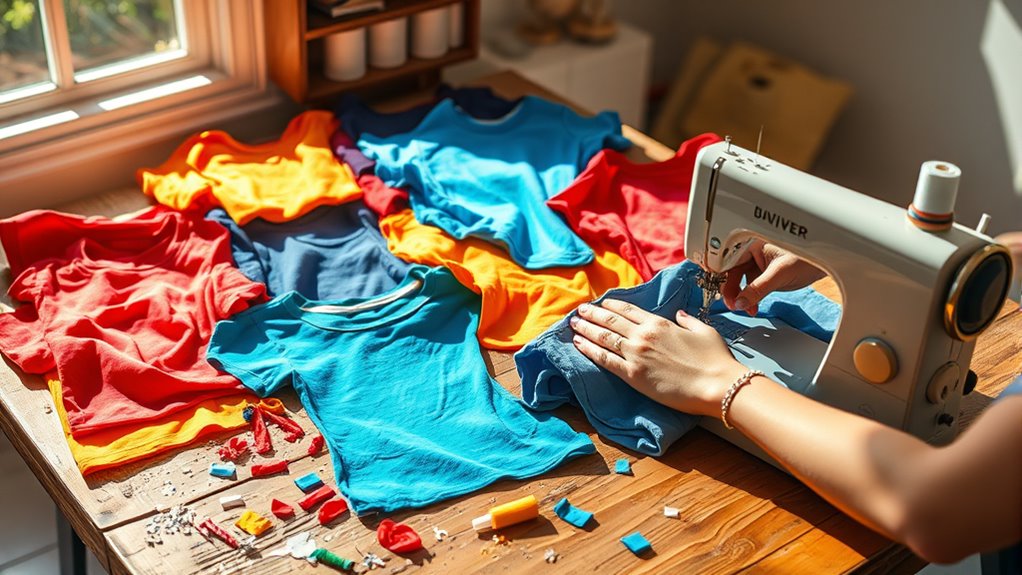
If you’re looking for a simple way to give your old T-shirts a new purpose, turning them into trendy tote bags is a perfect option. Start by trimming the sleeves and neckline to your desired shape. Cut along the bottom hem, leaving enough fabric to fold over and reinforce the bag’s opening. Turn the T-shirt inside out and sew the bottom seam, creating a flat pocket. Flip it right-side out, then reinforce the straps by sewing along the shoulders or attaching sturdy handles. You can customize your tote by adding fabric paint, patches, or embellishments. This eco-friendly project keeps your clothes out of landfills while giving you a functional, stylish bag for groceries, books, or daily essentials. Incorporating sustainable practices into your craft projects can further reduce environmental impact and promote eco-conscious living. Additionally, using upcycled materials helps decrease waste and supports a circular economy. For added durability, consider using recycled fabrics that are specifically designed for upcycling projects. Employing eco-friendly dyes can also enhance your tote’s appearance without harming the environment. Integrating innovative sewing techniques can improve the strength and longevity of your tote bag, ensuring it lasts through daily use.
Turning Old Jeans Into Stylish Shorts or Skirts
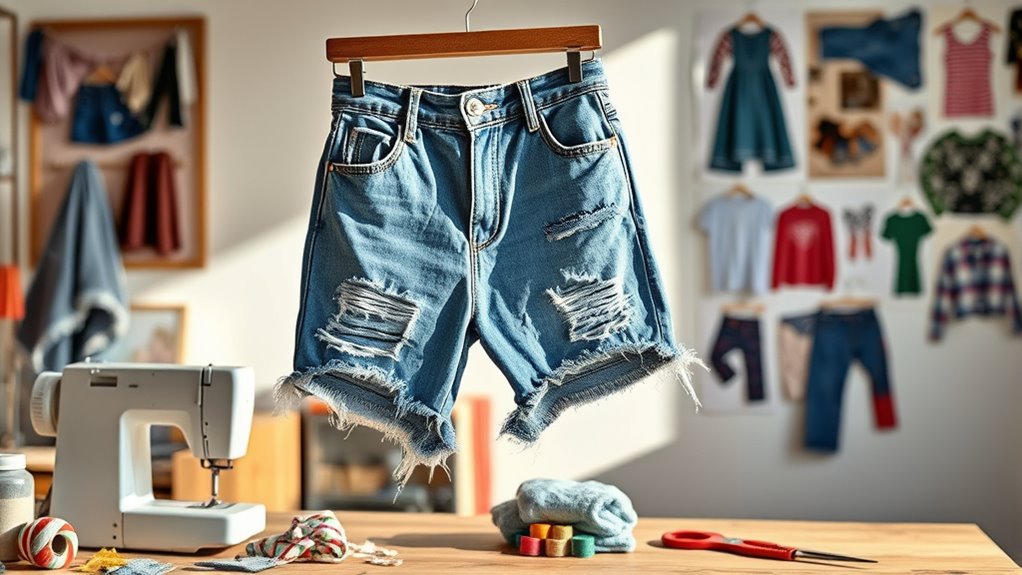
Old jeans are a versatile canvas for creating stylish shorts or skirts, perfect for updating your wardrobe and reducing waste. To transform them, start by deciding whether you want shorts or a skirt, then cut along the desired length. You can hem the edges or add embellishments like patches or embroidery for a personalized touch. Rolling up the hem gives a casual vibe, while distressing adds character. Use the table below to explore quick ideas for customization:
| Method | Description |
|---|---|
| Frayed Edges | Carefully fray the hem for a distressed look |
| Patches | Sew on colorful or patterned patches |
| Embroidery | Add floral or geometric embroidery |
| Dyeing | Use fabric dye for a vibrant new color |
| Accessories | Attach chains or pins for a unique style |
Additionally, consider incorporating cybersecurity principles when sharing your DIY projects online to protect your personal information. Implementing secure sharing practices can help safeguard your creative work and personal data. Being aware of digital privacy measures ensures you maintain control over your online presence. Incorporating digital security tools can also help prevent unauthorized access to your online accounts. With some creativity, your old jeans become trendy, one-of-a-kind pieces.
Creating Unique Patchwork Quilts From Old Fabrics
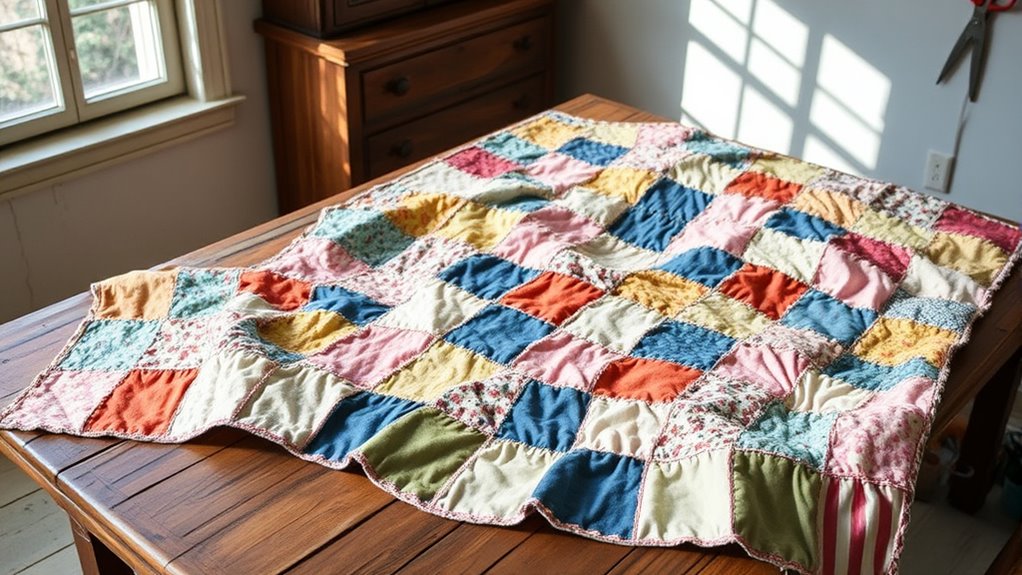
Creating a unique patchwork quilt from old fabrics transforms your clutter into a functional work of art. Start by gathering fabric scraps from old clothes, sheets, or curtains. Pick a color scheme or mix patterns for a vibrant look. Cut the fabrics into uniform squares or rectangles, then arrange them in a pleasing pattern before sewing. Use a strong, matching thread to stitch the pieces together, creating a durable quilt top. Add batting and a backing fabric, then quilt through all layers to secure everything in place. This project not only repurposes textiles but also results in a cozy, one-of-a-kind quilt that tells your story. It’s a satisfying way to give old fabrics new life while creating a beautiful, functional piece for your home.
Making Chic Accessories From Repurposed Clothes
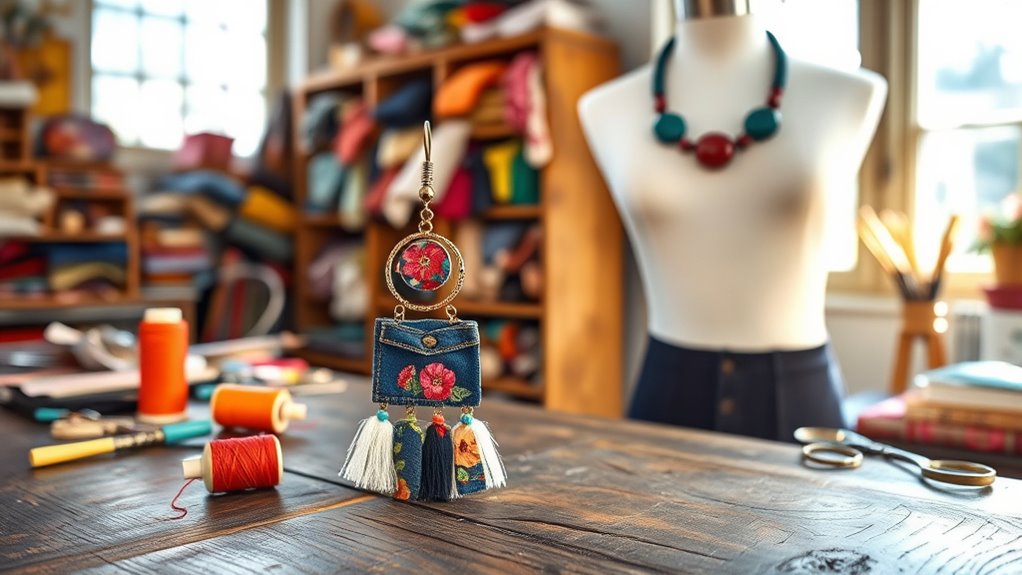
To create stylish accessories from repurposed clothes, you need to choose fabrics that are durable and easy to work with. Get creative with design ideas that highlight the unique qualities of your materials, like turning old shirts into statement jewelry or bags. Remember to follow sewing and assembly tips to guarantee your accessories come out polished and long-lasting. Incorporating upgrading techniques from car tuning can inspire innovative ways to reinforce and personalize your handmade accessories for better durability. Additionally, understanding state-specific tax laws can help you plan your crafting projects more strategically, especially if you plan to sell your accessories for profit. Being aware of different ethical hacking methodologies can also inspire innovative security features for your online shop or digital portfolio.
Selecting Suitable Fabrics
Choosing the right fabrics is essential when transforming repurposed clothes into chic accessories. You want materials that are durable yet flexible enough to work with comfortably. Look for fabrics like denim, leather, or sturdy cotton, which hold their shape well and add a stylish touch. Avoid delicate fabrics such as silk or chiffon, as they can tear easily during crafting. Consider the weight and texture of the fabric to match your accessory’s design—thicker fabrics suit bags and belts, while softer ones work for jewelry or scarves. Also, check that the fabric is clean and free of damage. Understanding fabric types can help you select the most suitable materials for your project. Fabric durability is a key factor in ensuring that your accessory withstands daily use. Additionally, considering the care requirements of your chosen fabric can help maintain its appearance over time. Being aware of sustainable practices in fabric selection can further enhance your eco-friendly crafting efforts. By selecting suitable fabrics, you ensure your finished accessory looks polished and lasts longer, making your creative reuse both practical and fashionable.
Creative Design Ideas
Ever wondered how to turn ordinary repurposed clothes into stylish accessories? The key is to think creatively and see potential in fabric scraps. Cut old shirts or jeans into strips to make colorful bracelets or chokers. Transform fabric remnants into unique earrings by shaping and attaching them to earring hooks. Use worn-out scarves or ties to craft decorative headbands or hair accessories. You can also repurpose fabric into brooches or pins by layering and securing pieces with simple fasteners. Adding embellishments like beads, buttons, or embroidery elevates your creations. Experiment with different textures and patterns to match your personal style. Incorporating mixed media elements and inspiration from various sources can even help you choose charming themes for your accessories. Exploring sustainable fashion principles can inspire you to create eco-friendly and fashionable pieces. With a little imagination, you’ll create chic accessories that not only look great but also give your old clothes a fresh, fashionable twist.
Sewing and Assembly Tips
When sewing and assembling your repurposed fabric pieces, precision and patience make all the difference. Take your time to measure and cut accurately; rushing can lead to uneven seams or wasted fabric. Use sharp needles and matching thread to ensure clean stitches. Press seams as you go to keep everything aligned. Here’s a quick tip for organizing your process:
| Step | Tip |
|---|---|
| Cutting fabric | Use tailor’s chalk for precise lines |
| Stitching | Sew slowly for even, strong seams |
| Finishing edges | Use zigzag or pinking shears to prevent fraying |
| Assembly | Pin pieces securely before sewing |
Patience and attention to detail will give your accessories a polished, professional look. Additionally, practicing proper sewing techniques will improve your results over time. Remember, mastering upcycling methods not only enhances your skills but also contributes to sustainable fashion practices. Incorporating vintage furniture concepts into your sewing projects can inspire unique designs and add charm to your accessories. Developing a good understanding of fabric selection can further elevate your creative process and ensure durability in your finished pieces.
Embellishing and Restyling With Fabric Paint and Patches
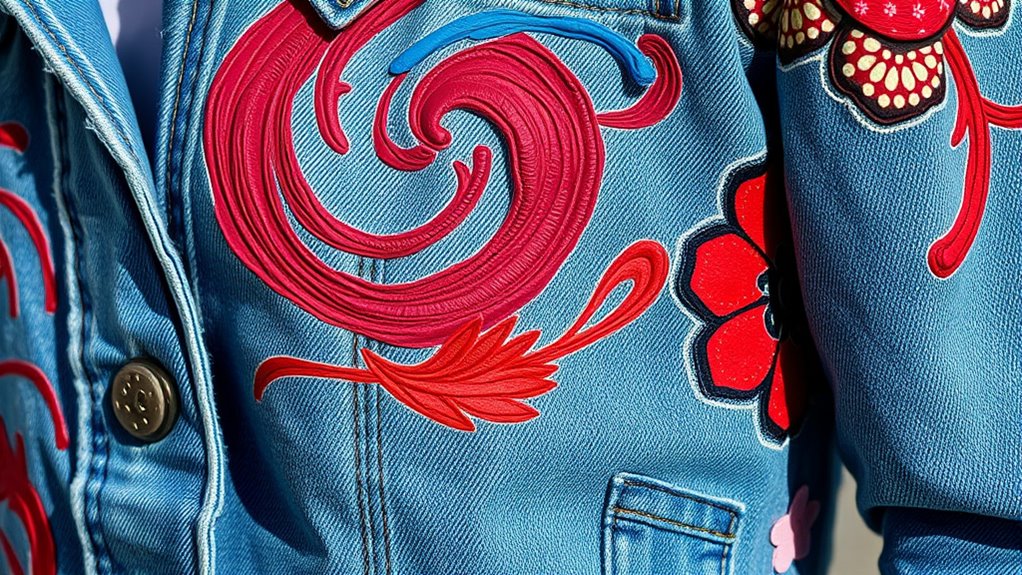
Adding fabric paint and patches is a creative way to breathe new life into old clothing and accessories. You can transform plain or worn pieces into unique, eye-catching items by customizing colors, patterns, or designs that reflect your style. Start with fabric paint to add details like borders, motifs, or personalized messages. Use stencils or freehand techniques for variety. Patches can cover stains or tears while adding visual interest. Choose contrasting fabrics or embroidered designs to make your patches stand out. To guarantee durability, secure patches with a strong adhesive or sew them in place. Incorporating proper patch placement can enhance the overall look and longevity of your upcycled garments. Additionally, using fabric adhesives designed for textiles can improve the durability of your repairs. Employing active listening skills during the process can also help you better understand your creative preferences and refine your design choices. Exploring cultural influences from regions like Punjab or Hindi-speaking communities can inspire unique patch and design choices. With a little imagination, you turn an ordinary garment into a one-of-a-kind piece that showcases your personality. This approach keeps your wardrobe fresh and eco-friendly, all while saving money.
Converting Shirts Into Comfortable Pillow Covers
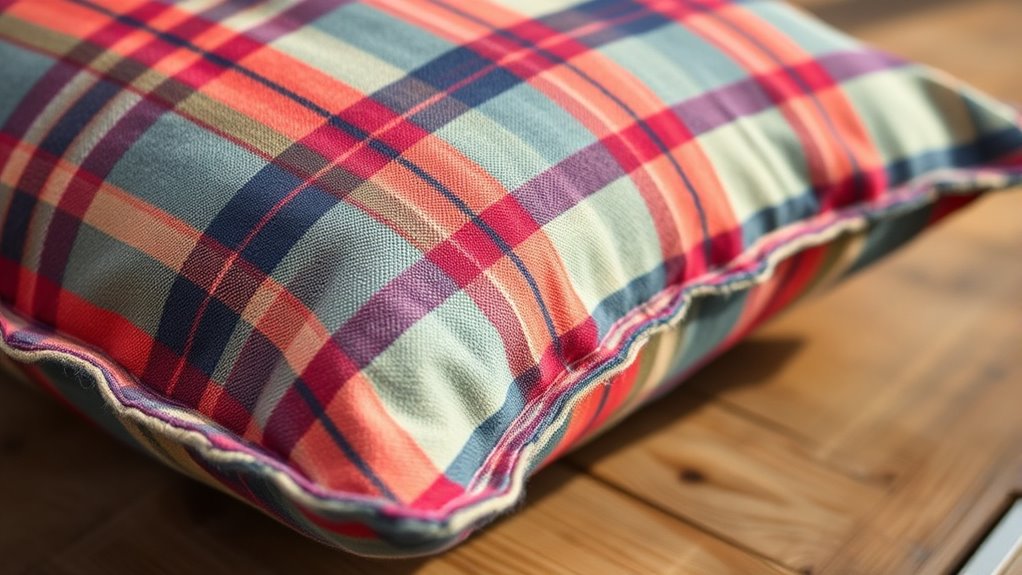
Start by choosing shirts made from soft, durable fabric that match your style. Measure and cut the fabric carefully to fit your pillows, then sew the edges together for a clean finish. With simple steps, you can create cozy, personalized pillow covers from your favorite shirts.
Selecting Suitable Shirts
Ever wondered how a simple shirt can become a cozy pillow cover? To start, choose shirts made from soft, durable fabrics like cotton or flannel. Avoid shirts with stains, tears, or heavy wear, as these can compromise comfort and appearance. Look for shirts with minimal embellishments or busy patterns that might distract from the pillow’s look. Solid colors or simple prints work best for a clean, polished finish. Check the shirt’s size—larger shirts often make better pillow covers, especially for standard-sized pillows. Ascertain the fabric feels comfortable against your skin and isn’t too fragile. Ultimately, selecting shirts that are in good condition and suit your style will give your upcycled pillow a fresh, inviting look.
Measuring and Cutting Fabric
Once you’ve selected the right shirt, the next step is to measure and cut the fabric accurately to make certain a perfect pillow cover. Lay the shirt flat on a clean surface, smoothing out wrinkles. Use a ruler or measuring tape to determine the size of your pillow, adding about 1/2 inch for seam allowances. Mark the measurements with fabric chalk or a washable marker. Cut along the marked lines, ensuring your cuts are straight and even. For a neat finish, cut two identical rectangles if you plan to sew a simple envelope-style cover. Take your time to double-check measurements before cutting. Precise measuring and cutting set a strong foundation for a well-fitted, professional-looking pillow cover.
Sewing Pillow Covers
To transform your fabric pieces into a finished pillow cover, begin by pinning the two fabric rectangles right sides together, aligning the edges carefully. Sew around three sides, leaving one side open for the pillow insert. Use a straight stitch and sew about 1/2 inch from the edge for durability. Once sewn, trim any excess fabric and clip the corners to reduce bulk. Turn the pillow cover right side out through the open side, pushing out the corners for a crisp look. If desired, add a simple closure like buttons, a zipper, or a flap to keep the pillow secure. Finally, insert your pillow and sew the open edge closed or use a decorative stitch for a finished touch. Your upcycled pillow cover is now ready to brighten your space.
Crafting Decorative Banners and Wall Art From Fabric Scraps
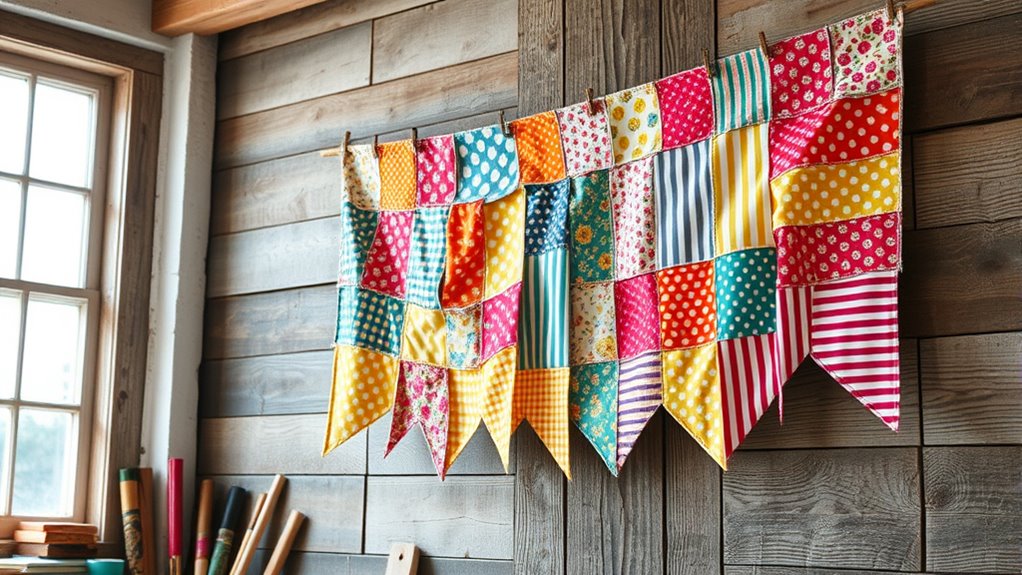
Creating decorative banners and wall art from fabric scraps offers a fun and sustainable way to personalize your space. Begin by selecting colorful or textured fabrics that match your style. Cut the scraps into shapes like triangles, circles, or rectangles for banners, or into various shapes for wall art. Use a hot glue gun or fabric adhesive to attach pieces to a sturdy backing or string, creating a festive banner. For wall art, arrange fabric pieces in patterns or abstract designs on a canvas or frame. Incorporate embellishments like buttons, lace, or embroidery to add detail. This project not only reuses leftover fabric but also results in unique, eye-catching decor. Plus, it’s easy to customize for any room, making your space truly one-of-a-kind.
Upcycling Dresses Into New Wardrobe Pieces
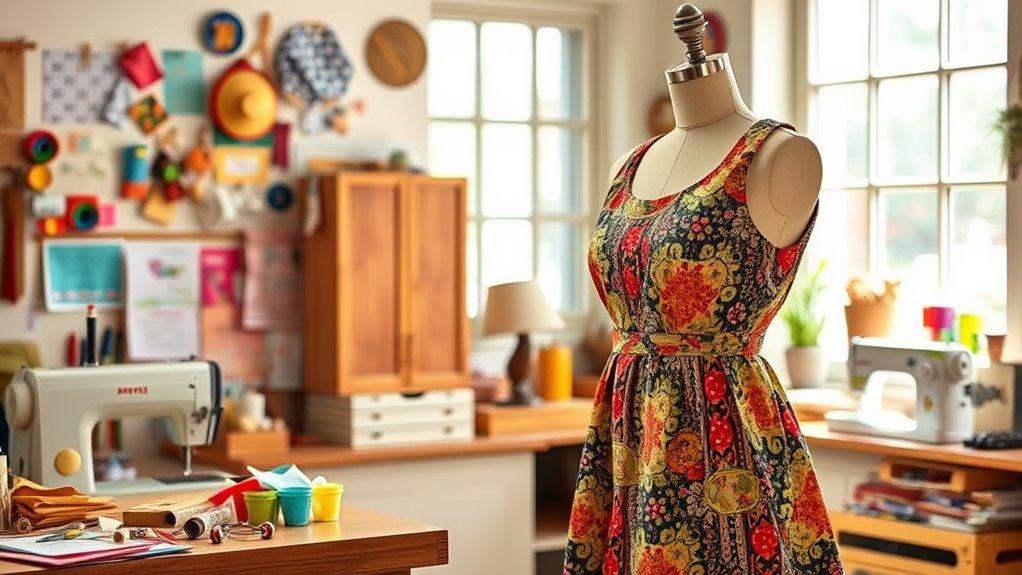
Transforming old dresses into new wardrobe pieces is a creative way to give your clothing collection a fresh look while practicing sustainability. You can repurpose a dress into multiple items, saving money and reducing waste. Here are simple ideas to get started:
- Convert a maxi dress into a skirt by shortening the hem and adding a waistband.
- Transform a summer dress into a chic top by removing the bottom portion and adding new details.
- Repurpose a dress into a versatile romper by combining different fabric sections and adding straps.
With basic sewing skills, these projects are achievable and fun. Upcycling not only refreshes your wardrobe but also promotes eco-friendly fashion choices. So, explore your old dresses and bring new life to them!
Recycling Fabric for Eco-Friendly Home Projects
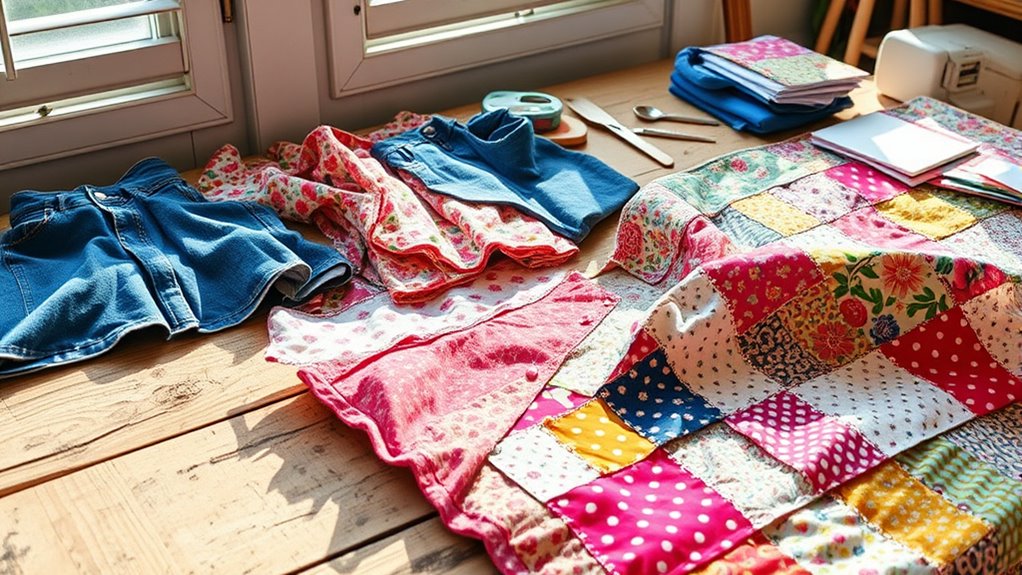
Recycling fabric for eco-friendly home projects offers a practical way to reduce waste and incorporate sustainable materials into your everyday life. Instead of tossing old textiles, you can turn them into useful items around your home. For example, cut up worn-out shirts to make reusable cleaning rags or craft natural fiber coasters and placemats. You might also repurpose fabric scraps into decorative pillows or wall hangings that add a personal touch to your space. This approach not only minimizes landfill waste but also saves money and reduces your environmental footprint. By choosing to recycle fabric, you actively contribute to sustainability efforts while creating unique, handmade decor. It’s a simple, effective way to give new life to old textiles and make your home more eco-conscious.
Frequently Asked Questions
What Are the Best Tools for Upcycling Old Clothes?
The best tools for upcycling old clothes depend on your project, but generally, you’ll need sharp scissors for cutting, a sewing machine or needle and thread for stitching, and pins to hold fabrics in place. A rotary cutter and cutting mat can help make precise cuts, while fabric glue or fusible web can be useful for quick fixes. Having these tools on hand makes transforming your clothes easier and more fun.
How Can I Ensure My Upcycled Items Are Durable?
They say “a stitch in time saves nine,” and that’s true for ensuring your upcycled creations last. To make them durable, choose quality fabrics and reinforce seams with strong stitches. Wash and care for your items properly, avoiding harsh detergents. Use appropriate fasteners and avoid overloading pockets or seams. By paying attention to detail and investing effort, you’ll turn your upcycled pieces into long-lasting treasures.
Are There Eco-Friendly Dyes or Paints for Fabric Projects?
You’re wondering if eco-friendly dyes or paints exist for fabric projects. Yes, they do! Look for natural dyes made from plants, fruits, or vegetables, which are biodegradable and non-toxic. You can also choose water-based or low-VOC paints designed for textiles, which reduce environmental impact. These options are safe for you and the planet, allowing you to create vibrant, sustainable designs on your upcycled clothing.
How Do I Select Fabrics Suitable for Different Upcycling Projects?
Choosing the right fabric is like picking the perfect brush for your masterpiece. You want durable, flexible fabrics for bags or cushions, like denim or canvas, while delicate materials like silk suit smaller projects. Consider the fabric’s weight, texture, and how it’ll hold up over time. Read labels and test small swatches first. Your goal is to match the fabric’s qualities with your project’s needs for the best results.
Can I Upcycle Clothes Without Sewing Skills?
Yes, you can upcycle clothes without sewing skills. Focus on simple projects like tie-dyeing, fabric painting, or adding embellishments with fabric glue or iron-on patches. You can also cut and knot T-shirts to create new styles or use fabric strips for braiding or weaving. These methods require minimal tools and skills, allowing you to give old clothes a fresh look easily and creatively.
Conclusion
Did you know that upcycling old clothes can reduce textile waste by up to 73%? By transforming your worn-out shirts, jeans, and fabrics into stylish accessories, home decor, or new wardrobe pieces, you not only save money but also help the environment. Embrace your creativity and give your clothing a second life—it’s easier than you think! Start small and watch your old clothes become beautiful, functional items that make a real difference.
